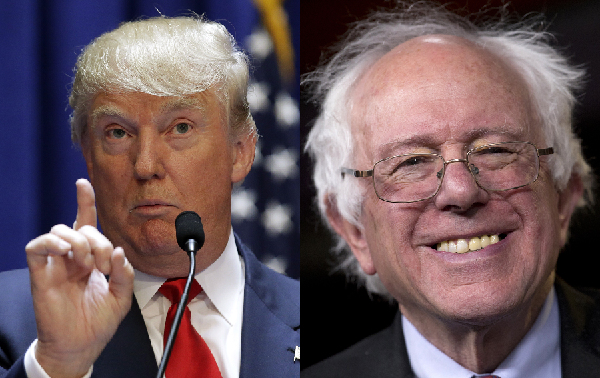Donald Trump and Bernie Sanders: How working class is changing USA
- By Heiko Khoo
 0 Comment(s)
0 Comment(s) Print
Print E-mail China.org.cn, March 25, 2016
E-mail China.org.cn, March 25, 2016
|
|
|
Donald Trump (left) and Bernie Sanders |
After the Great Recession of 2008 to 2009, the United States experienced a huge rise in inequality, home foreclosures, job insecurity and poverty. This period saw a dramatic collapse in the living standards of the white working class: better-off workers were hit hard. Many of them considered themselves to be middle class because for decades they experienced rising living standards, owned their homes, and enjoyed stable employment. Now, the younger generation is worse off than their parents, and even life expectancy is falling. To add insult to injury, the wealthiest people have accumulated nearly all new wealth produced since the crisis began.
The U.S. presidential election process is designed to draw the masses into political participation by deciding who leads the Democrats and Republicans before their chosen candidates square off in the presidential election in November. Traditionally, the two parties have not been as radically different as their rhetoric and personalities suggest. This is because they are both capitalist parties and the machinery of the government is designed to defend and perpetuate capitalist interests. So, the two parties draw on workers' support without really representing them in any meaningful way. The ideology and practice of neo-liberal economics, where the private sector is held to be good, and the public sector bad, has dominated their thinking. However, there is strong support for the two outsider candidates. Bernie Sanders, for the Democratic Party, and Donald Trump, for the Republican Party, both seem to represent the political consequences of the afore mentioned socio-economic crisis.
A recent Financial Times commentary, points out that the term "working class," although "once redundant, is now part of everyday conversation," and depicts "class warfare" organised against the majority. Indeed, back in 2000, only 33 percent of Americans identified as working class but, by last year, this figure had risen to 48 percent. Both Trump and Sanders appeal to working class constituencies seeking deep-seated change. The working class has effectively gate-crashed the campaigns of the two parties, in a way that horrifies the establishment's machinery of both the Democrats and the Republicans. Sanders advocates policies and ideas that Europe's labour and social-democratic workers' parties have traditionally stood for. However, the Democrats have never been a workers' party. The workers who support Trump tend to be less well educated and are attracted by his promises to be tough on immigration and foreign policy, and to protect U.S. jobs. Again, however, the Republican Party stalwarts fear that Trump will shift the entire party to the far right.







Go to Forum >>0 Comment(s)